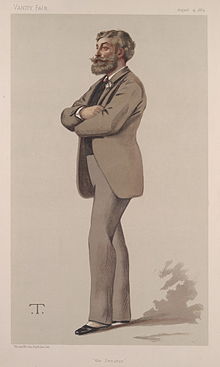- Cyril Flower, 1st Baron Battersea
-
 "The Senator". Caricature by T published in Vanity Fair in 1882.
"The Senator". Caricature by T published in Vanity Fair in 1882.
Cyril Flower, 1st Baron Battersea (30 August 1843 – 27 November 1907) was a British Liberal politician and patron of art.
Contents
Background and education
Flower was the son of Philip William Flower, of Furze Down, Streatham, Surrey, and his wife Mary, daughter of Jonathan Flower. He was born at Tooting in the 18th century Hill House and later lived in Streatham, both of which were rural environs at the time. He was educated at Harrow and Trinity College, Cambridge, and was called to the Bar, Inner Temple, in 1870.[1]
His father had earlier established a successful merchant house in Sydney, Australia. In 1838, Philip William Flower, and brother sailed to Australia in order to establish themselves as merchants in Sydney. In 1842 the partnership of Flower, Salting & Co was formed, shipping wool, tallow and gold to London. In 1842/3, Philip returned to London, the other end of the firm’s shipping routes, leaving his brother to oversee operations in Sydney. Upon his return to London, Philip, formed the firm of P.W. Flower and Co., and his property included Collier’s Quay and other London wharves. From 1867, and with other partners, Philip began developing part of the newly-laid-out Victoria Street in Westminster, St Philips Square was named by Philip Flower as was St Philip’s Church in its centre, which was consecrated in July 1870.
Property development
Like his father, Cyril also became involved in property development, and took on the development of Battersea's Park Town after the death of his father in 1872 (James Knowles, Junior was architect and surveyor for this development). Park Town was the lozenge-shaped estate running either side of Queens Road (now Queenstown Road), which extended from Battersea Park Road to Wandsworth Road. He also developed the mansion blocks lining the south side Prince of Wales Drive, London.
His business operations were centered in Albert Mansions, which were located opposite London Victoria Station.
Cyril had also acquired two cottages at Overstrand which his architect, Edwin Lutyens, developed to form ‘The Pleasaunce'.
Political career
In 1880 Cyril Flower entered Parliament for Breconshire, a seat he held until 1885 when the constituency was abolished, and then represented Luton until 1892. He served briefly as a Junior Lord of the Treasury from February to July 1886 in the third Liberal administration of William Ewart Gladstone. In 1892 Flower was raised to the peerage as Baron Battersea, of Battersea in the County of London and of Overstrand in the County of Norfolk.[2]
Patron of the art
Apart from his property development and political career he was also a great collector and patron of art. He was a patron of James McNeill Whistler and was involved with the Pre-Raphaelite set.
Personal life
Lord Battersea married Constance, daughter of Sir Anthony de Rothschild, 1st Baronet, in 1877. The marriage was childless. He died from pneumonia in November 1907, aged 64, when the barony became extinct. Lady Battersea died in November 1931.
References
- ^ Flower, Cyril (post Baron Battersea) in Venn, J. & J. A., Alumni Cantabrigienses, Cambridge University Press, 10 vols, 1922–1958.
- ^ London Gazette: no. 26323. p. 5090. 6 September 1892.
- Leigh Rayment's Peerage Pages
- Leigh Rayment's Historical List of MPs
- www.thepeerage.com==References==
- Stibbons, Peter and Cleveland, David Cleveland (2nd ed, 1985). Strands of Norfolk History, Poppyland Publishing.
- Metcalf, Priscilla (1978). "The Park Town Estate and the Battersea Triangle", London Topographical Society Publication, (No 121).
- The Rothschild Archive - Melaine Aspey, Archivist
- History of Innerleithen Church
- "Cyril Flowers, Lord Battersea", Who was Who 1897-1916
External links
- Portrait of Lord Battersea
- Lady Battersea at the National Portrait Gallery
- http://jwa.org/encyclopedia/article/rothschild-constance-lady-battersea
External links
- Hansard 1803–2005: contributions in Parliament by Cyril Flower
Parliament of the United Kingdom Preceded by
James Price William Gwynne-HolfordMember of Parliament for Breconshire
1880–1885Constituency abolished New constituency Member of Parliament for Luton
1885–1892Succeeded by
Samuel Howard WhitbreadPeerage of the United Kingdom New creation Baron Battersea
1892–1907Title extinct Categories:- 1843 births
- 1907 deaths
- Members of the United Kingdom Parliament for Welsh constituencies
- Members of the United Kingdom Parliament for English constituencies
- UK MPs 1880–1885
- UK MPs 1885–1886
- UK MPs 1886–1892
- Barons in the Peerage of the United Kingdom
Wikimedia Foundation. 2010.
